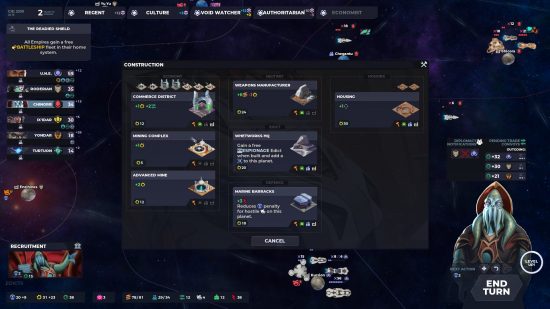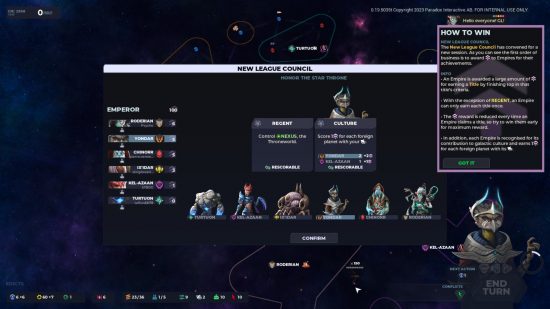Stellaris Nexus is an awesome space strategy game, but despite its name it isn’t very Stellaris. Now you’ve been warned, however, we can talk about the game on its own merits. And Stellaris Nexus has many merits. This game has lots in common with board games and may even be the best way to scratch your 4x itch without losing entire evenings to the dreaded ‘one more turn’ syndrome.
Stellaris Nexus has been billing itself as a 4x game you can play in your lunch break. So, if you’re misled by the title and jump in hoping to carefully customize a unique alien race, explore an interesting and unique galaxy, and tell a story through gameplay, it’s going to severely disappoint you.
Stellaris Nexus plays instead, like a quickfire, frenetic version of the truly epic strategy board game Twilight Imperium. Like Twilight Imperium, you each play an alien race with its own unique powers. Like Twilight Imperium you spread across a predetermined, cramped galaxy, with a central planet worth many points to fight over. And like that game you win by racking up victory points, partly earned by completing various public objectives which you have a chance to influence.
Unlike Twilight Imperium, playing Stellaris Nexus doesn’t take all day. To be honest, I have my doubts that you’d normally complete a match in an hour, as I’ve seen devs and Paradox people say. Trying to do so in a multiplayer session feels like playing speed chess when you’re not very good at chess: exhilarating but chaotic. Perhaps we were on the maximum turn timer and I’m just slow, but I think in singleplayer you’ll probably spend a couple of hours per game. Still pretty short for an epic scale turn-based game.
If you’re not limited by a turn-timer, what stops you from agonizing over every decision anyway is that there’s only a small number of choices you can make each turn. That’s because you’re limited in the number of actions you can take. You need a resource called ‘Support’ to do basically anything, and this works like an action point system – you get a limited number each go. And then you’re also limited in the type of actions you can take by the game’s clever edict system.
Now the edicts, these are very board-gamey. Essentially, each race gets its own, fairly similar deck of edict cards which determine everything they can do. Some might get more trade-y cards, others more build-y cards, and everyone gets a unique card type or two. But each turn you only draw three of them, so you only have a small number of things you can spend Support on each turn.
This sounds frustrating, but it works out very well. You’ll get through each card in your deck eventually, so you never miss out on any facet of the game. You’re never derailed by a bad draw. And rather than feeling constrained, the limited options helps you focus and take a turn in a short amount of time. This is great in singleplayer and vital if you’re in a multiplayer session with a turn timer measured in seconds, not minutes.
And (I’m mixed on this but it’s probably a wise decision) the military stuff is entirely decoupled from edicts, so you’re never left staring down an enemy fleet while unable to act. Building, reinforcing, and moving fleets still takes Support however, so if you enter a war you’ll likely have to stop using edicts for a while, which could see you falling behind.
While it isn’t the storytelling sandbox of Stellaris, Stellaris Nexus isn’t devoid of character. I enjoy the factions. I like their asymmetry – each one has a unique resource, and unique powers, and each of the faction’s three leaders levels up in a different way and provides a different unique edict card.
As the bug people, for instance, your leader wants to control as many planets as possible and can create brand new planets in empty space. But you could easily be the sneaky bugman, who’s all about espionage instead. Or you could play the bird zealots.
I think the User Interface needs a little more clarity, as realistically this is still a complex game and it needs to communicate its information to you very quickly. But there are some quality of life elements to Stellaris Nexus I really enjoyed. Having played my fair share of less than stellar digital board game adaptations, and clumsily flailed about on Tabletop Simulator, I was thankful for the fluidity of Stellaris Nexus, everything flowed and felt easy to use.
The inclusion of an undo button that can reverse every decision you make in a turn, from moving a ship to leveling up a leader, is great too and – and this has become a regular feature in Paradox games but it’s very welcome – you can hover over any icon or term and get a tooltip description of what it means. Excellent!
I was very impressed by what Whatboy Games has pulled off Stellaris Nexus. It’s a really fun, fast turn based game, and, whether you play it in mad-dash-multiplayer or still-breezy-singleplayer, a great experience.



